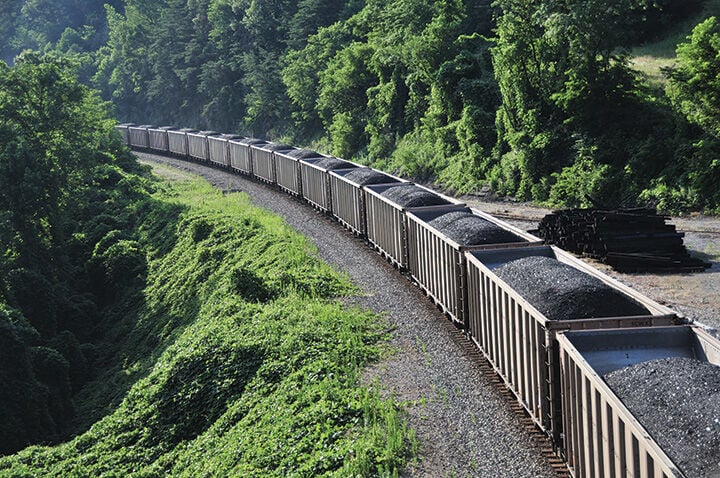Coal's Future in West Virginia Remains Uncertain Despite Federal Actions

October 18, 2025 - Southern West Virginia has struggled over the past few decades, dealing with the loss of its key economic driver — coal production.
Several government actions have been announced recently, especially by the administration of President Donald Trump.
However, whether those actions will bear fruit for the local economy remains to be seen, as the regulatory changes and actions enter into an uncertain marketplace and a very different landscape.

A train filled with coal is moved through the area in this 2012 file photo. Recent actions taken at the state and federal level are attempting to increase the use of coal, but experts say the effects the changes will have in southern West Virginia remain to be seen.
Appalachian Newspapers file photo
On Sept. 29, the U.S. Department of the Interior announced in a statement that it will be opening 13.1 million acres of federal land for coal leasing, while, at the same time, the U.S. Department of Energy announced $625 million in investment to "expand and reinvigorate America's coal industry."
The U.S. Environmental Protection Agency announced the repeal of numerous regulations set in the administration of Joe Biden.
According to a DOE statement, included in its $625 million investment is $350 million for "coal recommissioning and retrofit" for projects to "demonstrate readiness to recommission or modernize coal power units and provide near-term electric power reliability and capacity."
West Virginia Coal Association President and CEO Chris Hamilton believes these and other actions by the Trump administration will contribute greatly to reaffirmation of coal's role as a "reliable and affordable source of baseload power."
“(The Department of the Interior’s decision) is obviously a positive move for the coal industry … it will benefit our western partners more than us here in the east, but there are a couple of locations here in West Virginia — specifically in McDowell, Wyoming and Wayne counties as well as several in Alabama — where that will be really helpful,” Hamilton said. “So all in all, that was one thing announced a couple of weeks ago that was extremely encouraging.”
Hamilton said the DOE’s announcement of a $625 million investment was likely the most significant one made, specifically for West Virginia.
“These announcements are coming every week out of the president’s National Energy Dominance Council … which coordinates all the important actions from the three major departments ( the DOI, the DOE and EPA) so they can put a precise organization and coordinate the important work from those three major departments that have oversight and responsibility for the laws governing coal mining.”
“This was probably something that should have been done 25 or 30 years ago,” he continued, “but nonetheless it’s happening today and we’re just overwhelmed and very appreciative of all the work and all the personal attention that’s being applied to our industry from President Trump and his energy team.”
Though understandably optimistic, Hamilton tempered his enthusiasm by adding that it’s going to require some time for the wheels of this particular reenergized locomotive to build up to an optimal cruising speed.
“It’s going to take a little time for all this to come together and to really show results on the ground, but the fact is the narrative has really changed dramatically in the first nine months of Trump’s presidency,” Hamilton said. “And what it’s doing is it’s building a foundation for future growth and economic activity around our state’s coalfields. Of course everything is not all rosy because the market for metallurgical coal is weak right now … world demand has fallen off sharply.”
This dramatic freefall, Hamilton said, has been due to China “flooding the world with extremely cheap steel,” as well as because of an ongoing trade war between Australia — currently the world’s largest metallurgical coal producer and exporter — and China.
“We’ve seen some slowdowns and we’ve seen some layoffs, but we’re definitely seeing a lot of things change for long-term growth and development here from the coal sector,” Hamilton said.
According to the U.S. Energy Information Administration, between 2001 and 2023, coal production in the United States fell by 49 percent, from 1.1 billion short tons to just under 578 million short tons.
West Virginia coal production fell by 48 percent, from 162 million short tons in 2001 to just under 78 million in 2023.
Coal production in Kentucky fell at an even more precipitous rate, the data shows, declining by 79 percent from nearly 134 million short tons produced in 2001 to just over 28 million short tons produced in 2023.
According to data from the Appalachian Regional Commission, in 2000, just over 12,000 people were employed in the coal mining industry in Appalachian Kentucky. By 2023, the data shows, that number had fallen to 3,292 throughout the region, a decline of nearly 73 percent. The data shows that a total of 15,121 were employed in coal mining in West Virginia in 2000, while just over 14,000 were employed in the industry in the Mountain State in 2023.
While Hamilton believes it’s not likely the region will ever again return to a time when coal represented the economic juggernaut for southern West Virginia it once did, he does believe the industry still has the chance to be a major player in the region’s economic fortunes for decades to come.
“I think everyone agrees that it’s very unlikely we’re going to see a time like we saw 20-25 years ago, but coal is still a valuable commodity, it’s still the best fuel source known to man at the current time, and we certainly have the adequate reserves and supplies coming out of our mountains in West Virginia,” Hamilton said. “You have to have metallurgical coal to make steel for infrastructure build out, and they’re also going to increase their power needs as those economies grow. We’re trying to dig out of the trenches that Biden put us in and Obama put us in before that. Our current president isn’t taking any prisoners and he’s doing everything he can to put us on a positive track going forward.”
Mainly because bringing life back to the coal industry has been moving at a breakneck pace on a national level over the last several months, Hamilton said state officials have understandably been a little slow to react but seemingly now are definitely catching up with the national movement.
“The state’s definitely been on board with everything, but we’ve been going through realignment and transition, so right now things have not been going at the pace that we like to see it,” Hamilton said. “But everyone is coming together, everybody sees the opportunity and is more than prepared and willing to do their part today.”

